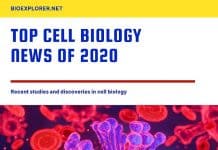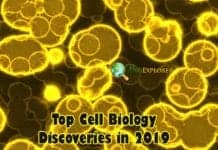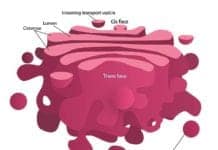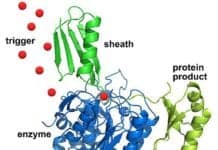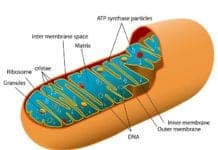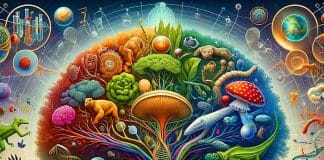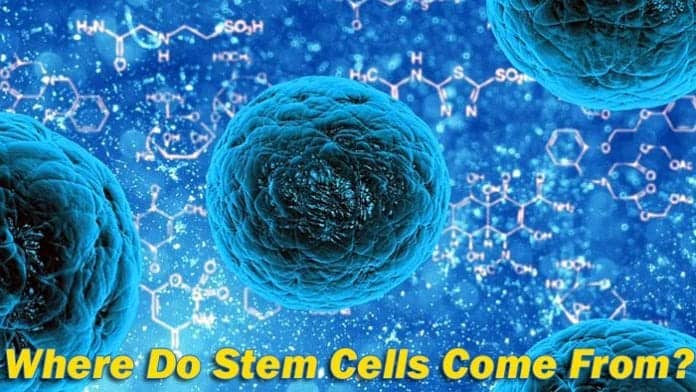
Stem cells are a group of cells found at specialized sites in the body that have the potential to develop into different cell types. They remain undifferentiated, and cells produced upon differentiation can either become a differentiated cell or remain undifferentiated as a stem cell.
Table of Contents
Stem cells are found and originate in the early stages of embryonic growth, as part of the embryo, placenta or umbilical cord, known as embryonic stem cells. Adult stem cells are cells found in adult somatic tissues, dividing when prompted by damage. Placental or umbilical cord cells are located in the placenta and are harvested after birth to be stored in cord banks for future use.
Depending on the tissue/organ they are found in, stem cells can give rise to various cell types. In some tissues, like blood, stem cells divide on a regular basis to replace lost cells, whereas in other tissues they divide only when required, or under certain conditions such as damage.
There are broadly three types of stem cells – totipotent, pluripotent and multipotent. Totipotent cells can form all the cells of the body and the embryonic and extraembryonic cells. Pluripotent cells can differentiate into all the cell types that make up the body. Multipotent cells can form one or more than one types of cells of the body.
An essential characteristic difference between normal cell and stem cells is their unlimited differentiation capability, or ability to divide and renew themselves through cell division. Another marked difference is the potential of stem cells to divide and differentiate into different cell types under specific physiological conditions.
What Are Stem Cells?
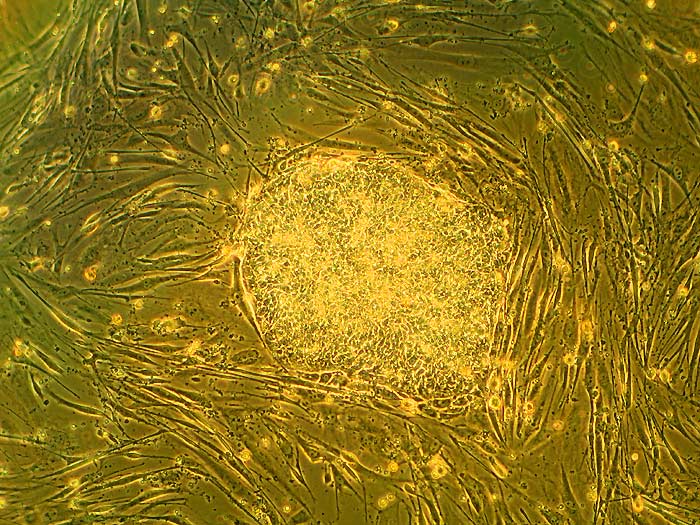
Stem cells are scientifically defined as unspecialized or undifferentiated cells found in specific environments throughout the body, and that can retain their ability to differentiate into different types of cells, usually of the same family or lineage.
- Stem cells act as a repair system providing new cells to replace those that have been damaged or lost. Due to this feature, they are an important asset in therapy.
- All stem cells have three important features: they are found in an unspecialized, undifferentiated state, they have the potential of unlimited cell division, and they can produce specialized cells.
- Stem cells have the unique capability to divide incessantly and can produce millions of progeny cells. Unlike their regular adult counterparts, stem cells can proliferate for prolonged periods producing cells that either remains unspecialized or differentiate into one or more cell types.
- No specific function can be attributed to stem cells. They lack any particular structures or functions that commit them to become one type of cell. Their only function is to produce specialized cells.
The process by which a stem cell differentiates or specializes is regulated by mechanisms at the genetic level, the interaction of stem cells with its neighboring cells, and factors present in the micro-environment that promote differentiation. When a stem cell differentiates, it goes through multiple stages of specialization gradually becoming completely differentiated into the desired cell type.

Types of Stem Cells
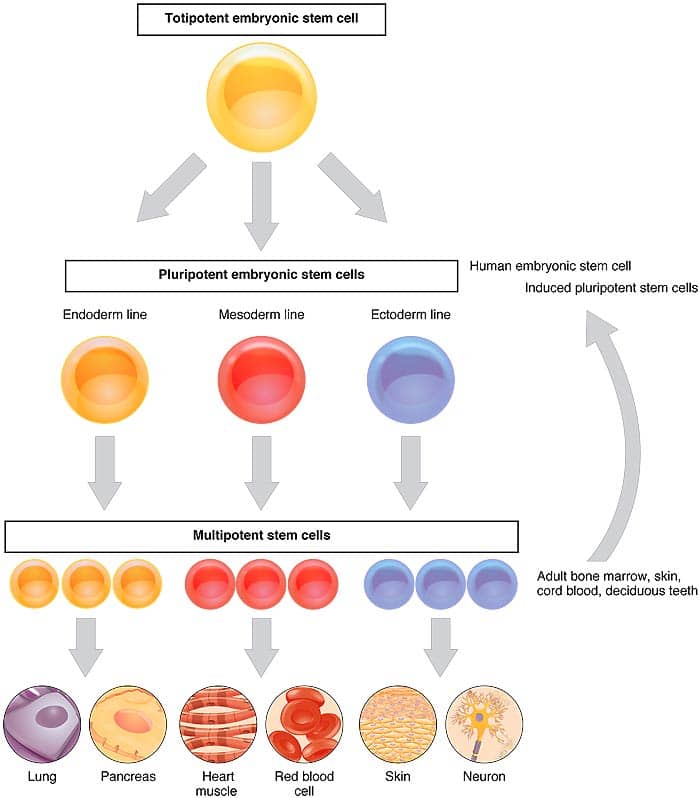
Stem cells are broadly classified into a few subtypes based on their potency for cell division and differentiation capability:
- Totipotent
- Pluripotent
- Multipotent
- Oligopotent
- Unipotent
- Induced Pluripotent (iPSC)
Totoipotent stem cells can proliferate to produce all the cell types of the body as well as the embryonic, extra-embryonic layers such as chorion, yolk sac, placenta, etc.
- These stem cells are found in the fertilized cell after the first few divisions and can give rise to all the cell types of the body of an individual.
- They hold immense regenerative potential but cannot be harvested from their niche for therapeutic applications.

Pluripotent stem cells are cells that can differentiate into all the cell types of the body except the extra-embryonic and embryonic layers.
- They can form the three germ layers which are the ectoderm, mesoderm and endoderm and cells arising from them. Therefore, they can build any tissue or organ in the body.
- These stem cells are found in the embryo. They are used in medical therapy by donated embryos. However, a lot of ethical concern circulates their harvest and use in therapeutic applications.

Multipotent stem cells can form one or more specialized cell types, usually, within a lineage.
- All adult stem cells are characterized as multipotent. An example of multipotent stem cells are the mesenchymal stem cells that differentiate and give rise to bone cells, muscle cells, cartilage and fat cells.

Oligopotent stem cells can proliferate into few specialized cell types, within the same family or related lineage. In other words, the proliferative capacity of oligopotent stem cells is limited.
- An example of oligopotent stem cells are the hematopoietic stem cells that give rise to all the different types of lymphoid cells – red blood cells, white blood cells, and platelets, as well as all the different myeloid cell types of the immune system such as the T cells, B cells, etc.

Unipotent stem cells have the least proliferative capacity among all the types.
- Their capacity is limited to only one cell type. An example of unipotent stem cells are the muscle cells, which differentiate into just a single cell type.
Induced pluripotent stem cells are a type of lab-grown or human-made stem cells that are produced by reprogramming multipotent or adult stem cells back to the pluripotent state.
By introducing genes necessary to maintain a pluripotent state, reprogramming multipotent stem cells into induced pluripotent cells, provides a more natural alternative to using embryonic pluripotent stem cells, that are surrounded by medical ethical concerns.

Where Are Stem Cells Found & Where Do They Come From?
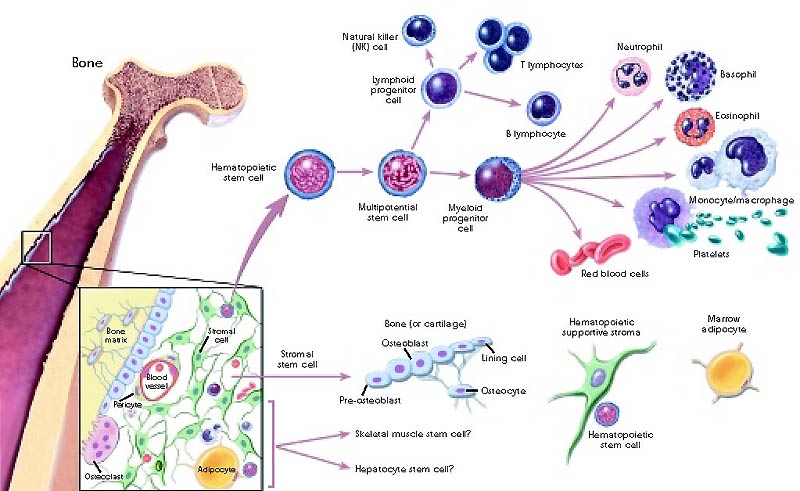
Stem cells typically originate from the fertilized cells in the very first few cell divisions. As stated earlier, these cells are totipotent and can generate the cell types of the entire body.
- All other stem cells arise or originate from these totipotent cells over the course of embryonic development. Embryonic pluripotent stem cells originate from totipotent cells in the fertilized egg.
- They are found in the blastocyst stage. The blastocyst further gives rise to the embryonic layers – ectoderm, mesoderm, and endoderm, as well as the extra-embryonic layers like the placenta and the umbilical cord. As embryonic development progresses, embryonic pluripotent stem cells give rise to adult multipotent stem cells that further differentiate within their lineage to give rise to one or more cell types of that lineage. Stem cells are also found in the extra-embryonic layers such as cord blood and placenta and are known to be pluripotent.
- The microenvironment in which stem cells are found that helps them to differentiate by promoting proliferation and cell division is called the stem cell niche. Stem cell niches are typically found in every organ. For example, the niche of hematopoietic stem cells in the stromal tissue in the bone marrow. The stem cell niche of cardiovascular or heart cells is found in the right ventricle of the heart. Many small molecules, biomarkers, cell surface receptors and signaling pathways are involved in the differentiation of a stem cell in the niche.
Based on niche, stem cells are of three types:
- Embryonic stem cells that are found in and originate from the embryonic layers of the blastocyst.
- Placental or umbilical cord stem cells that are found in and originate from the placenta and umbilical cord. For this reason, cord blood banks have been established for individuals who wish to store the umbilical cord or cord blood, for future therapeutic use.
- Adult stem cells that are found in and originate from specific tissues and organs of the body based on the lineage. Each type of adult stem cell has a particular niche. Examples of adult stem cells include cardiovascular stem cells, retinal stem cells, neural stem cells, pancreatic stem cells, etc. , and are found in a conserved microenvironment in the specific organs.

Benefits/Functions of Stem Cells In Medicine/Therapy
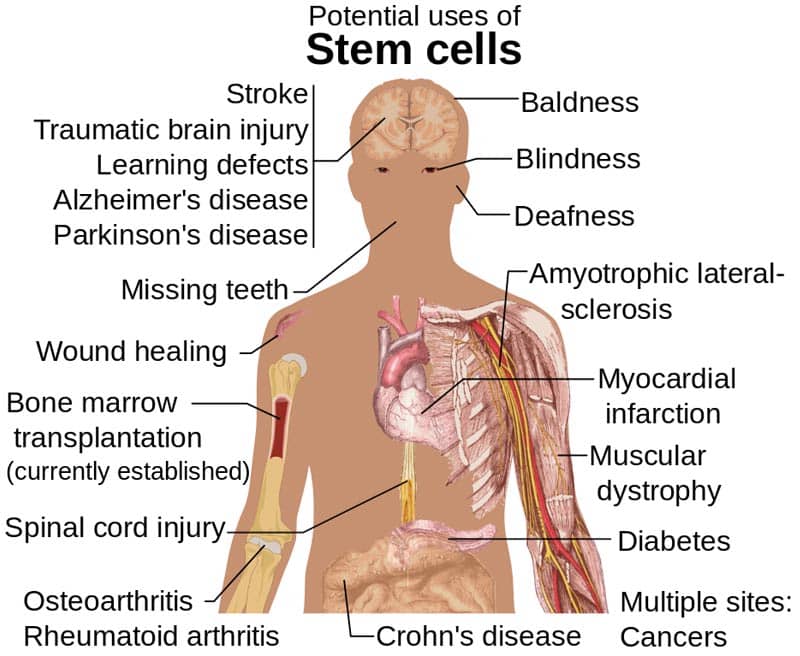
- Stem cells have great potential therapeutically. An extensive area of medical research has been in the area of their application in diabetes. Diabetes is caused by the inability of the pancreatic islet cells to produce the hormone insulin, or by the inefficiency of the cells to take up insulin from the blood.
- Harvesting stem cells from the pancreas, or use of induced pluripotent stem cells to produce B-islet cells that can make insulin for treatment of diabetes, has been one of the research aims in this stem cell therapeutics.
- Other areas of therapy include cardiovascular, where stem cells have been used in regenerating heart muscle fibers in patients suffering from heart disease; use of stem cells in the treatment of blindness by regenerating retinal cells etc.

Identification of the stem cell niche is an important aspect of stem cell application. Knowing where stem cells come from is paramount to their use in therapy and research.

Cite This Page
References
- “Stem Cell Basics I. | stemcells.nih.gov”. Accessed February 24, 2018. Link.
- “What is a stem cell? | Facts | yourgenome.org”. Accessed February 24, 2018. Link.
- “What is the difference between totipotent, pluripotent, and multipotent? | NYSTEM”. Accessed February 24, 2018. Link.
- “Do You Know the 5 Types of Stem Cells?”. Accessed February 24, 2018. Link.
- “What are the major types of stem cells?”. Accessed February 24, 2018. Link.
- “Stem-cell niche”. Accessed February 24, 2018. Link.



